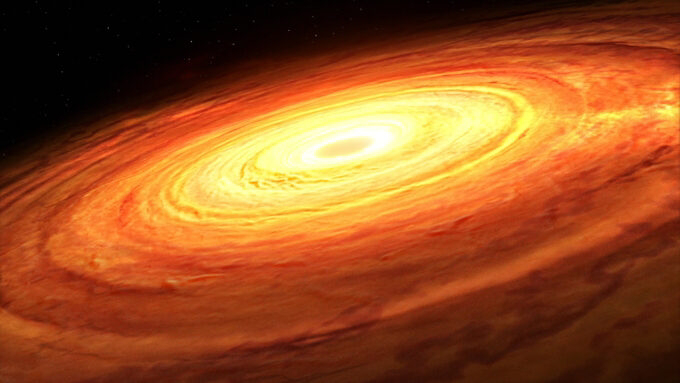Measuring a black hole’s mass isn’t easy. A new technique could change that
Measuring a black hole’s mass isn’t easy. A new technique could change that
Flickering in the gas and dust of the accretion disk of a black hole provides hints of its mass
Astronomers have figured out how to use the disk of hot gas and dust around some black holes (like the one shown in this artist’s illustration) to measure the black hole’s mass.
MARK A. GARLICK, SIMONS FOUNDATION
An actively feeding black hole surrounds itself with a disk of hot gas and dust that flickers like a campfire. Astronomers have now found that monitoring changes in those flickers can reveal something that is notoriously hard to measure: the behemoth’s heft.
“It’s a new way to weigh black holes,” says astronomer Colin Burke of the University of Illinois at Urbana-Champaign. What’s more, the method could be used on any astrophysical object with an accretion disk, and may even help find elusive midsize black holes, researchers report in the Aug. 13 Science.
It’s not easy to measure a black hole’s mass. For one thing, the dark behemoths are notoriously difficult to see. But sometimes black holes reveal themselves when they eat. As gas and dust falls into a black hole, the material organizes into a disk that is heated to white-hot temperatures and can, in some cases, outshine all the stars in the galaxy combined.
Measuring the black hole’s diameter can reveal its mass using Einstein’s general theory of relativity. But only the globe-spanning Event Horizon Telescope has made this sort of measurement, and for only one black hole so far (SN: 4/22/19). Other black holes have been weighed via observations of their influence on the material around them, but that takes a lot of data and doesn’t work for every supermassive black hole.
So, looking for another way, Burke and colleagues turned to accretion disks. Astronomers aren’t sure how black holes’ disks flicker, but it seems like small changes in light combine to brighten or dim the entire disk over a given span of time. Previous research had hinted that the time it takes a disk to fade, brighten and fade again is related to the mass of its central black hole. But those claims were controversial, and didn’t cover the full range of black hole masses, Burke says.
So he and colleagues assembled observations of 67 actively feeding black holes with known masses. The behemoths spanned sizes from 10,000 to 10 billion solar masses. For the smallest of these black holes, the flickers changed on timescales of hours to weeks. Supermassive black holes with masses between 100 million and 10 billion solar masses flickered more slowly, every few hundred days.
“That gives us a hint that, okay, if this relation holds for small supermassive black holes and big ones, maybe it’s sort of a universal feature,” Burke says.
Out of curiosity, the team also looked at white dwarfs, the compact corpses of stars like the sun, which are some of the smallest objects to sport consistent accretion disks. Those white dwarfs followed the same relationship between flicker speed and mass.
The analyzed black holes didn’t cover the entire possible range of masses. Known black holes that are from about 100 to 100,000 times the mass of the sun are rare. There are several potential candidates, but only one has been confirmed (SN: 9/2/20). In the future, the relationship between disk flickers and black hole mass could tell astronomers exactly what kind of disk flickers to look for to help bring these midsize beasts out of hiding, if they’re there to be found, Burke says.
Astrophysicist Vivienne Baldassare of Washington State University in Pullman studies black holes in dwarf galaxies, which may preserve some of the properties of ancient black holes that formed in the early universe. One of the biggest challenges in her work is measuring black hole masses. The study’s “super exciting results … will have a large impact for my research, and I expect many others as well,” she says.
The method offers a simpler way to weigh black holes than any previous technique, Burke says — but not necessarily a faster one. More massive black holes, for example, would need hundreds of days, or possibly years, of observations to reveal their masses.
Upcoming observatories are already planning to take that kind of data. The Vera C. Rubin Observatory is expected to start observing the entire sky every night beginning in 2022 or 2023 (SN: 1/10/20). Once the telescope has been running long enough, the observations needed to weigh black holes “will fall out for free” from the Rubin Observatory data, Burke says. “We’re already building it. We may as well do this.”



Comments
Post a Comment